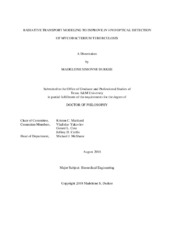| dc.description.abstract | Tuberculosis (TB) is the deadliest disease caused by a single organism, killing 1.7 million people in 2016. TB is especially deadly in immuno-compromised populations, including HIV-positive patients and children. In 2014, HIV-associated TB was responsible for roughly one-third of all deaths associated with HIV/AIDS, and TB was one of the top ten causes of death in children. Additionally, drug resistant strains of the causative agent, Mycobacterium tuberculosis (Mtb), have emerged, and those infected with these strains have an elevated mortality rate. There is a need for a rapid testing of new treatment regimens in pre-clinical studies, and a need for a sensitive, rapid diagnostic tool for childhood TB.
In vivo optical detection of Mtb has previously been used to study disease pathogenesis in small animal models. However, whole-animal imaging suffers from a high detection threshold and high-intensity tissue autofluorescence (TAF) background signal. Intravital illumination of the lung has significantly reduced this detection threshold and is a potential tool for longitudinal studies of therapeutic efficacy. However, the system is not robust enough to provide reproducible results at low bacterial doses, and its current detection threshold is 1-2 orders of magnitude higher than the infectious dose of Mtb. We have developed an optical model of the mouse torso and Mtb infection to understand the physiological limitations imposed on the optical system and the sensitivity of the system to experimental variability. The optical model is validated with multiple iterations of phantoms to assess the capability of the model to simulate radiative transport in three-dimensional complex structures, porous and multi-layered materials, and fluorescent materials. We explore the efficacy of different illumination methods and show the system sensitivity to manipulations of the intravital source. The optical model also shows that the tissue-limited detection threshold of the system is between 10 and 100 colony forming units, and that TAF will further increase this detection threshold if the TAF cannot be spectrally separated from bacteria fluorescence. The fluorescence model is extrapolated to a human child, showing the potential to detect a manifestation of childhood TB known as miliary TB. Finally, we simulate and test an external mirror device to enhance luminescence collection in a mouse model of infection. The validated fluorescence model of infection is shown to accurately replicate previous pre-clinical experiments and accurately predicts the signal enhancements provided by external mirror devices. The extrapolation of the model to the torso of a human child is expected to be a valid preliminary estimate of the performance of the optical system as a clinical diagnostic of TB in children. | en |


